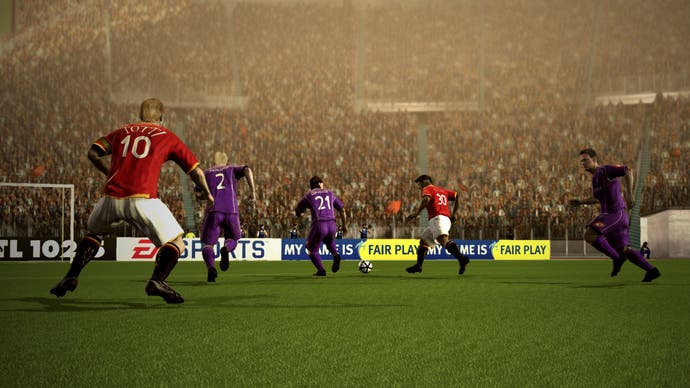FIFA 08
Ohhh you beauty!
I'm watching a video of Alessandro Faiolhe Amantino Mancini scoring for Roma against Lyon in the Champions League. EA's Joe Booth turns it off and says: "We want to give the user that kind of freedom to improvise." Since you couldn't be bothered to click on the video link above even after I went and bloody well found it for you, he means that you should be able to feint right from standing, feint left, step-over right, feint left, step-over right, step-over left, step-over right, exit to the defender's left and put the ball into the roof of the net from six yards, all within one fluid, exacting motion that remains completely under your control. What's brilliant about FIFA 08 is that you actually can do that, it blends logically into the game, and it looks bloody amazing.
There's times, listening to Booth and his colleagues Gary Paterson and Kaz Makita, and playing around in the Arena mode with Ronaldinho, that FIFA sounds like the most realistic football game ever made. Consider what happens when you take a shot. Often you just kick the ball and don't think about it. Frank Lampard certainly does. The 22-page design document for FIFA 08's shot system, which Paterson walks us through, suggests EA does think about it.
The ball, now completely freed from the animation system, is influenced by variables most of us never think about. The connecting foot's angle and position in 3D space is the starter step. Then it factors in its lateral and incoming velocity, the air pressure and density, and the mass of the ball, among other things. The endless graphics on Paterson's Word document show the multitudinous possible outcomes. "Once upon a time we used to compute error by saying, okay, the guy's trying to shoot into the top-corner, we want to do error so we're going to move it into space over here," Joe Booth explains, waving his arms about. "But that's not how real physics works, so what we do now is apply the error to the ball, so you get much more subtlety." Like the Reynolds effect. Which is what, maths-man Gary Paterson? "It's where you hit it so hard the spin doesn't have any effect on the ball until it's slowed down enough. Like Roberto Carlos' goal against France." Aha.

The other part of what happens when you strike the ball is down to the player. "The key thing for us is to try and analyse the context in which the shot was taken, to try and understand how the player would then kick the ball in that situation," says Paterson. "Once we understand how he would kick the ball we can then apply the errors that would be realistic for football." For example, they've made certain animations slightly longer. "It kind of feels like it would be counterintuitive because you think your responsiveness is going to go down if that's the case," he adds, anticipating concerns. "But it doesn't really, because you see the player trying to kick the ball and that's enough for you." He makes a good point. When people's-champion Steven Gerrard shapes to hit a shot, he needs time and composure. The player logically expects to need that in a game, and shapes his tactics to build towards an authentic shooting opportunity. That realism keys into the emotions the player feels. "When Steven Gerrard gets into space 25 yards from goal and he's got enough space to take a touch and set himself up for goal," says Paterson, allowing us to shoehorn more Steven Gerrard mentions into this paragraph, "that's when the spectators feel that anticipation. We want that in FIFA."

Football, for me at least, is all about the aesthetic beauty, the search for a truly original goal. When Torsten Frings wrapped his foot around the ball in the last minute of Germany's World Cup opener against Costa Rica, I leapt out of my chair as it rose and swerved violently into the top corner. "A lot of those goals that continue to rise into the back of the net is down to backspin, and if you get your ball physics right that comes through," Paterson notes. In concert with ball physics and shot maths, then, comes the animation system. It's rooted in last year's "LocoMotion" system, which separated the ball from animation, and allowed the player to react dynamically to where the ball is. Last year's barely perceptible limitations (apparently it had to guestimate the final metre of logic in certain obscure situations) are sorted, and now it can handle things like walking, slow-dribbling, and all sorts of other permutations. "The animation system allows us to be a lot more explicit and a lot more sophisticated with how we kick the ball," says Paterson. "We have animations for when the ball's close, we have animations for when the ball's far so you're stretching at it. Power animations, placed animations."


